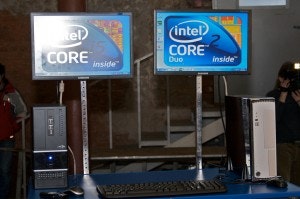A funny thing has happened over the last few years. Big tech companies, which for many years shunned the idea of paying dividends, have now started offering some of the best dividends in the market. Although these dividends are fairly new, some of these tech stocks are perfect for my Ultimate Dividend Growth Portfolio. I introduced this paper portfolio in a previous article with the aim of creating a rapidly growing dividend stream by finding the best dividend growth stocks. I started with $100,000 and so far have added four stocks, Lorillard Inc. (NYSE:LO), Kraft Foods Group Inc (NASDAQ:KRFT), General Electric Company (NYSE:GE), and Walgreen Company (NYSE:WAG). Today I’ll add four more stocks, this time from the tech sector.
Tech stocks are tricky
Because technology can change extremely fast, it’s important to only choose tech stocks that have staying power. Big, fairly diversified companies are best, and having a load of cash on the books doesn’t hurt either. You could certainly argue that the stocks I’ll add today are riskier than the previous four, but I believe they offer an excellent opportunity to capture significant dividend growth.
Intel Corporation (NASDAQ:INTC)

Of course, as less PC’s are sold more tablets and smart phones are sold, so the total number of devices continues to increase. And as Intel begins to find itself inside more of these mobile devices PC sales won’t matter nearly as much. The key is selling more chips, not where those chips end up.
Intel Corporation (NASDAQ:INTC) currently pays a quarterly dividend of $0.225 per share with a yield of 4.15%. This is the highest yield of the four stocks I’ll talk about today, and to some degree it’s so high because Intel’s stock is down about 26% from its 52-week high. Interesting, the dividend yield is now higher than the coupon rate on most of Intel’s outstanding bonds, even the long-duration ones.
Historically Intel’s dividend has grown quite fast. Over the past decade the dividend has grown at an annualized rate of 30%, although that rate has slowed substantially recently. The latest dividend hike last year only increased the quarterly dividend by 7.14%, and we should see another increase later this year.
According to my previous article a stock with a 4% yield only needs to grow its dividend at about 5.5% annually to be fairly priced, so Intel’s last increase was above the mark. Going forward, the next few years will probably be difficult ones as Intel claws its way into the mobile space. In 2012 Intel’s payout ratio was 57% of the free cash flow and 40% of the net income. This is high enough that any dividend increase in the near-term will be a result of earnings growth, as I doubt Intel wants to raise the payout ratio much further. But again, because of the high yield growth doesn’t need to be all that fast.
Based on the share price as of this writing I’ll add 230 shares of Intel Corporation (NASDAQ:INTC) to my Ultimate Dividend Growth Portfolio with a cost basis of $4,986.40. This position will generate a projected annual dividend payment of $207. If the stock price rises back near its 52-week high, pushing the yield down closer to 3%, I’ll probably dump Intel in favor of a faster growing dividend stock. But the yield right now is too tantalizing to ignore.
Microsoft Corporation (NASDAQ:MSFT)
In the same spirit as Intel Microsoft will probably have a rough time in the near-term as well. The long-term success of both Intel and Microsoft are linked in the form of Windows 8 tablets, although Microsoft is actually a far more diversified company than many people think. While the Windows and Office divisions make up a large portion of revenue the Server and Tools division is actually about the same size as either one of them. This includes Microsoft SQL Server, Windows Server, and Visual Studio. There’s also the Entertainment division, which includes the Xbox, Skype, and Windows Phone. This division isn’t quite as big but it’s still significant.
Microsoft Corporation (NASDAQ:MSFT) increased its quarterly dividend late last year by 15% to $0.23 per share, pushing the yield up to about 3.2%. Historically Microsoft has grown its dividend at an annualized rate of 28% over the past decade, but much like Intel Corporation (NASDAQ:INTC) this rate has recently slowed. The payout ratio was just 22% of free cash flow and 38% of net income in 2012, meaning that Microsoft has plenty of room to grow the dividend. Another positive is that Microsoft has about $64 billion, or $7.60 per share, of net cash on the books. This money could easily go towards a dividend boost or share buybacks, which would decrease the payout ratio by reducing the number of shares.
According the my table from the previous article Microsoft has to grow its dividend at about 9% annually to be fairly valued, and it seems that this shouldn’t be any problem at all. The average analyst estimate for 5-year annual earnings growth is just above 9%, and with such a low payout ratio and a mountain of cash I expect dividend growth to be substantially higher.
Based on the share price as of this writing I’ll add 173 shares of Microsoft to my Ultimate Dividend Growth Portfolio with a cost basis of $4,980.67. This position will generate a projected annual dividend payment of $159.16.
Cisco Systems, Inc. (NASDAQ:CSCO)
Cisco only started paying a dividend in 2011 and has already raised it three times. The most recent increase earlier this month was a 21% hike to $0.17 per quarter per share, putting the projected yield at 3.16%. Cisco spent most of the last decade buying back shares instead of paying a dividend, but the new policy now seems shifted towards returning profits to shareholders in a more balanced way.
Cisco Systems, Inc. (NASDAQ:CSCO) is the behemoth of the networking industry, with a dominant market share in switches and routing, the backbone of the internet. Cisco has continued to grow revenue despite increased competition, and the most recent quarter saw a year-on-year revenue increase of 5%. Like Microsoft Corporation (NASDAQ:MSFT) Cisco is sitting on a huge pile of cash, with $31 billion or $5.77 per share in net cash on the books.
Based on the projected dividend of $0.68 annually Cisco’s payout ratio in 2012 was just 35% of free cash flow and 45% of the net income. Much like Microsoft Cisco is in a position where it can substantially increase the dividend by expanding the payout ratio. On average analysts expect 8.27% earnings growth annually over the next 5 years, and with a yield similar to that of Microsoft Corporation (NASDAQ:MSFT) this combined with the low payout ratio should easily allow Cisco to beat the 9% required growth rate.
If Cisco Systems, Inc. (NASDAQ:CSCO) can grow FCF at, say, 6% per year for the next ten years the company could increase its dividend by 10% annually and reach a 50% FCF payout ratio at the end of the tenth year. And if the company buys back its own stock during this time the dividend could be raised even faster.
Based on the share price as of this writing I’ll add 233 shares of Cisco to my Ultimate Dividend Growth Portfolio with a cost basis of $5,018.82. This position will generate a projected annual dividend of $158.44.
Apple Inc. (NASDAQ:AAPL)
Much like Cisco Apple started its dividend recently, just last year in fact. When Apple paid its first dividend the stock was still on its upward march to $700, and at that price the yield was just 1.5%. But the rapid decline of the stock since that high to around $430 per share has raised the yield to a respectable 2.5%, making the stock much more attractive.
The fall in stock price came as skepticism regarding future growth began to take hold. Android devices were gaining share, offering cheaper alternatives to the iPhone and iPad, and Apple hadn’t offered a revolutionary product in a few years. Now, with hedge fund manager David Einhorn pushing Apple to do something with its enormous pile of cash, investors have gotten extremely impatient with the once darling company.
Apple Inc. (NASDAQ:AAPL) does have a lot of cash – $137 billion or $144 per share. The annual dividend is only $10.60 per share right now, so the cash alone could cover this dividend for over 13 years. Using this projected dividend in 2012 the payout ratio was 24% of both free cash flow and net income.
This is why I’ve chosen Apple for the Ultimate Dividend Growth Portfolio. The potential for dividend increases in the future is enormous. If Apple grows its free cash flow by 6% annually for the next ten years the dividend could be raised by 14% annually during that time for the payout ratio to reach 50% by year ten. According to my table from the previous article a yield of 2.5% requires dividend growth of 11.5% for the stock to be fairly valued, so it looks like Apple should have no problem achieving this.
And with the giant cash hoard the company could purchase enough shares to slow the increase of the payout ratio. Imagine this scenario: the company reduces the share count by 20% over the next 10 years. At today’s prices that would only be $80 billion, which Apple could cover today with its cash and certainly with its cash flows over the next decade. In my previous calculation at the end of 10 years of 14% annual dividend hikes the payout ratio would be just 41.7% if these buybacks are enacted. The dividend would have to be increased by 16% annually to reach a 50% payout by the end of 10 years.
The point I’m trying to make is that the potential for dividend growth here is huge. Based on prices as of this writing I’ll add 12 shares of Apple Inc. (NASDAQ:AAPL) to my Ultimate Dividend Growth Portfolio with a cost basis of $5,157.60. This position will generate a projected annual dividend of $127.20.
The next step
After these four additions The Ultimate Dividend Growth Portfolio now has 8 positions and has used 40% of its cash. Next time I’ll add a few more dividend growth stocks which have exceptional potential and further flesh out this portfolio.
If you want to see what the portfolio looks like and what transactions I’ve made you can go hereto see the current state of the portfolio at any time. This will allow you to follow the portfolio and see changes I’ve made before I write about them.
I’ll leave you with what the portfolio now looks like. See you next time.


Graphics created with infogr.am
Timothy Green owns shares of Microsoft and Cisco. The Motley Fool recommends Apple Inc. (NASDAQ:AAPL), Cisco Systems, Inc. (NASDAQ:CSCO), and Intel. The Motley Fool owns shares of Apple, Intel, and Microsoft.



